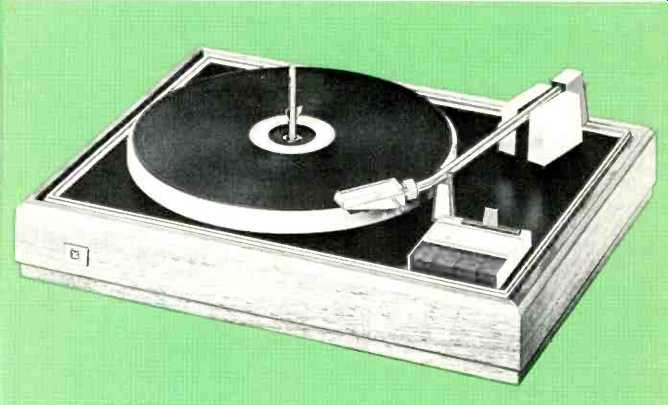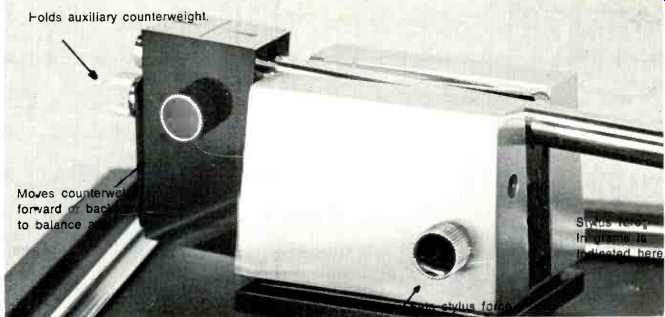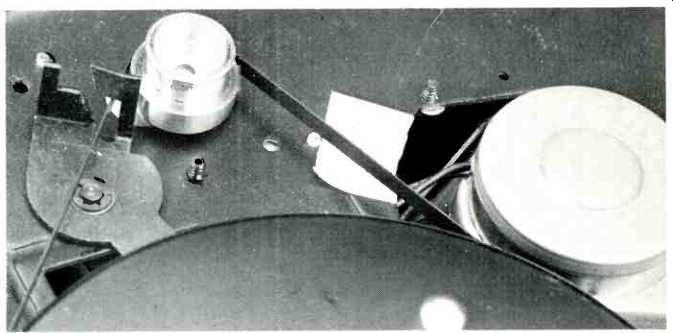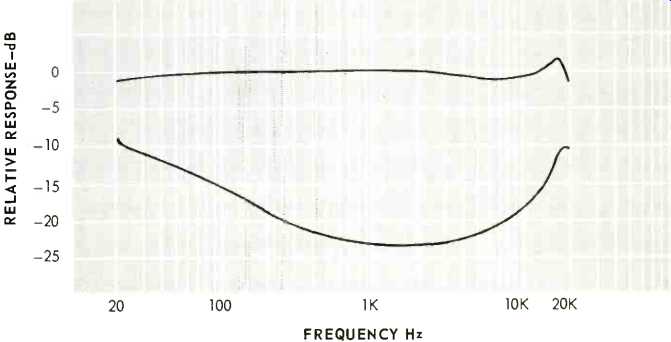
MANUFACTURER'S SPECIFICATIONS:
Speeds: Two, 33 1/3 and 45 rpm.
Motors: two, synchronous; one for turntable, one for cycle change.
Dimensions: 18 3/4" wide, 14 3/4" deep, 6 1/2" high over dust cover.
Weight: 20 lbs.
Price: $220, with Shure M-71 cartridge, dust cover, and base.
For some strange reason, there have been no truly high fidelity record changers made in the U.S.A. for almost the history of the high fidelity industry.
There have been many excellent single play turntables made here, and very few anywhere else in the world, but the high quality changer has remained the province of the Germans and the British, with one recent importation from Italy which looks good, but which we have not tested to date.
The new V-M "Synchro-Matic" does qualify as a high fidelity changer, and it offers a number of features not exhibited heretofore in automatic turntables.
Audiophiles have often been worried about the use of a single motor for both record turning and the operation of the changing mechanism, in spite of the excellent performance that several European manufacturers have gotten out of single-motor automatics. The audio buff who sticks with his single play turntable will argue that the better tape recorders have three motors, so why can't a turntable have a motor for each function-which would require but two, while the professional tape recorders need three for the functions of rewinding, take-up, and the constant speed capstan drive.
The V-M is the first automatic we have seen that employs two motors. Both are small "clock-type" synchronous designs, with the turntable motor revolving at 300 rpm and the changer motor turning at a geared-down 4 rpm, but still completing its change cycle at 13 seconds at either turntable speed.
The operating procedure of the V-M turntable is as follows: After actuating the cycle-by depressing either the automatic or manual play keys or by the arm on completion of a record-the turntable motor stops, the arm rises and swings to the right, the next record is lowered half way to the platter, its diameter is sensed by the arm, which then backs off about 1/8 in., the record is lowered to the platter, the arm moves in to the first-groove position, the turntable starts rotating, and the arm lowers gently to the record. That is quite a complicated procedure, but it is controlled by a single cam driven directly by the change-cycle motor, geared down to 4 rpm. During the cycle, a switch wafer driven by the shaft of the change-cycle motor shorts the pickup leads for silence during the change. While the record is playing, the arm has no mechanical connection with any of the cams and levers of the changing mechanism. It has an extension of arcuate form which obscures the light from a small lamp, preventing it from shining on a photo-sensitive cell. At the end of the play, the end of the extension moves past the light beam, which illuminates the cell and inaugurates the change cycle. The operating cam is a die-cast disc with grooves and convolutions on it which actuate the various levers that perform the multitudinous movements to cause the change. The center spindle, with its three arms, is actuated by a flat beryllium-copper spring strip which is moved horizontally, parallel to the chassis, then is guided around a curved path to end up as a vertical motion in the spindle.
The turntable proper-an aluminum stamping with its rubber pad neatly finished-rests on the "drive turntable," another stamping which is driven by a flat rubber belt from the drive motor turning at 300 rpm. Change of speed is accomplished by a lever which coaxes the belt from the smaller diameter of the motor shaft for the 33 1/3 speed to the larger diameter for the 45, and back again as directed by the control just back of the operating keys. Raised numbers are uncovered as the control is moved from one position to the other to indicate the turntable speed.
The arm is an aluminum tube with a 28-deg. bend near the head, which plugs into a socket in the end of the arm. The head-a plastic molding, chrome "plated" by the usual evaporation process-is held in place by a collet like ring, and accommodates the cartridge in an adjustable position to compensate for variations in overhang.
Balancing the arm is simplified by a knob which actuates a roller that bears on the underside of the arm extension and moves the weight forward and backward as the knob is turned. Auxiliary metal strips are provided to increase the mass of the counter-weight for cartridges heavier than normal.
After the arm and cartridge are balanced, the stylus force is set by another knob on the left side Of the arm mounting, with the force being indicated through a small hole in the front of the housing. A height adjustment screw is accessible from the top of the mount, while another adjustment for stylus landing is accessible once the platter is removed-a simple operation, since it is held onto the drive turntable by a "C" washer.
The mechanism is supported from the chassis plate by rubber mounts to reduce the effect of external bumps or vibration on the unit. Cup washers can be inverted over the rubber mounts to lock the mechanism to the chassis plate for transporting.
At the rear of the unit are three openings-one for the power cord, one for an accessory a.c. outlet, and one for the signal output phono receptacles, along with a ground screw. Four good-sized rubber feet serve to hold the mechanism into the walnut-finished case, which provides excellent protection to the mechanism with its fiber-board bottom plate. An attractive smoky plastic dust cover fits onto grooves in the base.
Operation
Four operating keys are provided--stop, automatic, manual, and cue. As many as six records may be stacked on the spindle, and automatic play is started by depressing the auto key. For manual playing, a single record is placed on the spindle and the manual key is depressed, starting a change cycle, lowering the record to the platter, and bringing the arm over the starting groove, where it can be lowered by depressing the cue key. The arm may be lifted at any place by again depressing the cue key, and lowered again into the same groove by another action of the key.

Fig. 1--Close-up of arm moulting and counterbalance.

Fig. 2--Close-up of turntable drive motor pulley and belt-shifting mechanism.
Belt is in the 45 rpm position.
Performance
Before actually using the unit to play records, we made all the usual tests and measurements, using the Shure M71MB cartridge with which the unit is equipped. In the important range 6 to 250 hz-we found wow-and-flutter to be a low .06%, which increased to only 0.1% in the range from 0.5 to 6 Hz. The signal-to-noise ratio measured 34 dB, unweighted, which would approximate 54 dB if we convert this to the "audible rumble loudness level," which more accurately describes the effect on the ear with the average home system.

Fig. 3--Frequency response curves of the V-M Synchro-Matic 1555 equipped
with a Shure M71MB cartridge.
The 13-second change cycle was constant for either speed of the turntable, as would be expected since it is the result of using a separate motor for the changing operation. Most changer mechanisms are driven by the turntable platter itself, and at different speeds the time of cycling varies.
In playing use, the unit performed as its measurements indicated, with consistent operation over a number of hours of listening. The V-M "Synchro-Matic" is built economically, with the use of plastics where they would suffice, as is usual with modern designs. But we could find no fault with their use in the performance of the unit. We did find one "problem" in its operation--with a single record on the platter, de pressing the manual key would cause a change cycle, and then the turntable drive motor would stop. A little study taught us that the turntable motor could be persuaded to continue if we stopped the arm during the cycle at the time it was "feeling" the diameter of the record. That was the simple answer to the puzzling behavior of the unit, and once we learned that, the problem ceased to exist.
-C. G. McP.
(Audio magazine, Feb. 1971)
Also see:
Miracord 770 turntable (ad, Feb. 1971)
Miracord 760 turntable (ad, Jan. 1975)
Elac/Miracord turntable-cartridge systems (Feb. 1970)
Miracord 50 H-II Automatic Turntable and Record Changer (May 1972)
= = = =